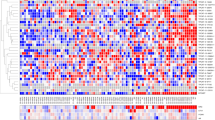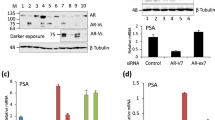Abstract
Although recent studies have indicated roles of long non-coding RNAs (lncRNAs) in physiological aspects of cell-type determination and tissue homeostasis1, their potential involvement in regulated gene transcription programs remains rather poorly understood. The androgen receptor regulates a large repertoire of genes central to the identity and behaviour of prostate cancer cells2, and functions in a ligand-independent fashion in many prostate cancers when they become hormone refractory after initial androgen deprivation therapy3. Here we report that two lncRNAs highly overexpressed in aggressive prostate cancer, PRNCR1 (also known as PCAT8) and PCGEM1, bind successively to the androgen receptor and strongly enhance both ligand-dependent and ligand-independent androgen-receptor-mediated gene activation programs and proliferation in prostate cancer cells. Binding of PRNCR1 to the carboxy-terminally acetylated androgen receptor on enhancers and its association with DOT1L appear to be required for recruitment of the second lncRNA, PCGEM1, to the androgen receptor amino terminus that is methylated by DOT1L. Unexpectedly, recognition of specific protein marks by PCGEM1-recruited pygopus 2 PHD domain enhances selective looping of androgen-receptor-bound enhancers to target gene promoters in these cells. In ‘resistant’ prostate cancer cells, these overexpressed lncRNAs can interact with, and are required for, the robust activation of both truncated and full-length androgen receptor, causing ligand-independent activation of the androgen receptor transcriptional program and cell proliferation. Conditionally expressed short hairpin RNA targeting these lncRNAs in castration-resistant prostate cancer cell lines strongly suppressed tumour xenograft growth in vivo. Together, these results indicate that these overexpressed lncRNAs can potentially serve as a required component of castration-resistance in prostatic tumours.
This is a preview of subscription content, access via your institution
Access options
Subscribe to this journal
Receive 51 print issues and online access
$199.00 per year
only $3.90 per issue
Buy this article
- Purchase on Springer Link
- Instant access to full article PDF
Prices may be subject to local taxes which are calculated during checkout




Similar content being viewed by others
References
Gupta, R. A. et al. Long non-coding RNA HOTAIR reprograms chromatin state to promote cancer metastasis. Nature 464, 1071–1076 (2010)
Heinlein, C. A. & Chang, C. Androgen receptor in prostate cancer. Endocr. Rev. 25, 276–308 (2004)
Scher, H. I. & Sawyers, C. L. Biology of progressive, castration-resistant prostate cancer: directed therapies targeting the androgen-receptor signaling axis. J. Clin. Oncol. 23, 8253–8261 (2005)
Petrovics, G. et al. Elevated expression of PCGEM1, a prostate-specific gene with cell growth-promoting function, is associated with high-risk prostate cancer patients. Oncogene 23, 605–611 (2004)
Chung, S. et al. Association of a novel long non-coding RNA in 8q24 with prostate cancer susceptibility. Cancer Sci. 102, 245–252 (2011)
Chu, C., Qu, K., Zhong, F. L., Artandi, S. E. & Chang, H. Y. Genomic maps of long noncoding RNA occupancy reveal principles of RNA-chromatin interactions. Mol. Cell 44, 667–678 (2011)
Kypta, R. M. & Waxman, J. Wnt/β-catenin signalling in prostate cancer. Nature Rev. Urology 9, 418–428 (2012)
Fu, M. et al. Acetylation of androgen receptor enhances coactivator binding and promotes prostate cancer cell growth. Mol. Cell. Biol. 23, 8563–8575 (2003)
Yang, L. et al. ncRNA- and Pc2 methylation-dependent gene relocation between nuclear structures mediates gene activation programs. Cell 147, 773–788 (2011)
Zippo, A. et al. Histone crosstalk between H3S10ph and H4K16ac generates a histone code that mediates transcription elongation. Cell 138, 1122–1136 (2009)
heintzman, N. D. et al. Histone modifications at human enhancers reflect global cell-type-specific gene expression. Nature 459, 108–112 (2009)
Hu, R. et al. Ligand-independent androgen receptor variants derived from splicing of cryptic exons signify hormone-refractory prostate cancer. Cancer Res. 69, 16–22 (2009)
Sun, A. et al. Adeno-associated virus-delivered short hairpin-structured RNA for androgen receptor gene silencing induces tumor eradication of prostate cancer xenografts in nude mice: a preclinical study. Int. J. Cancer 126, 764–774 (2010)
Taberlay, P. C. et al. Polycomb-repressed genes have permissive enhancers that initiate reprogramming. Cell 147, 1283–1294 (2011)
Wang, Q., Carroll, J. S. & Brown, M. Spatial and temporal recruitment of androgen receptor and its coactivators involves chromosomal looping and polymerase tracking. Mol. Cell 19, 631–642 (2005)
Gu, B. et al. Pygo2 expands mammary progenitor cells by facilitating histone H3 K4 methylation. J. Cell Biol. 185, 811–826 (2009)
Wang, D. et al. Reprogramming transcription by distinct classes of enhancers functionally defined by eRNA. Nature 474, 390–394 (2011)
Gu, B., Watanabe, K. & Dai, X. Pygo2 regulates histone gene expression and H3 K56 acetylation in human mammary epithelial cells. Cell Cycle 11, 79–87 (2012)
Lam, M. T. Y. et al. Rev-Erbs repress macrophage gene expression by inhibiting enhancer-directed transcription. Nature 498, 511–515 (2013)
Li, W. et al. Functional roles of enhancer RNAs for oestrogen-dependent transcriptional activation. Nature 498, 516–520 (2013)
Zhao, J. et al. Genome-wide identification of polycomb-associated RNAs by RIP-seq. Mol. Cell 40, 939–953 (2010)
Langmead, B., Trapnell, C., Pop, M. & Salzberg, S. L. Ultrafast and memory-efficient alignment of short DNA sequences to the human genome. Genome Biol. 10, R25 (2009)
Heinz, S. et al. Simple combinations of lineage-determining transcription factors prime cis-regulatory elements required for macrophage and B cell identities. Mol. Cell 38, 576–589 (2010)
Quinlan, A. R. & Hall, I. M. BEDTools: a flexible suite of utilities for comparing genomic features. Bioinformatics 26, 841–842 (2010)
Saeed, A. I. et al. TM4 microarray software suite. Methods Enzymol. 411, 134–193 (2006)
Zang, C. et al. A clustering approach for identification of enriched domains from histone modification ChIP-Seq data. Bioinformatics 25, 1952–1958 (2009)
Robinson, M. D., McCarthy, D. J. & Smyth, G. K. edgeR: a Bioconductor package for differential expression analysis of digital gene expression data. Bioinformatics 26, 139–140 (2010)
Liu, W. et al. PHF8 mediates histone H4 lysine 20 demethylation events involved in cell cycle progression. Nature 466, 508–512 (2010)
Tsai, M. C. et al. Long noncoding RNA as modular scaffold of histone modification complexes. Science 329, 689–693 (2010)
Liao, D. F., Monia, B., Dean, N. & Berk, B. C. Protein kinase C-ζ mediates angiotensin II activation of ERK1/2 in vascular smooth muscle cells. J. Biol. Chem. 272, 6146–6150 (1997)
Acknowledgements
We are grateful to X. Dai for providing the PYGO2 shRNA and cDNA constructs and J. Hightower for assistance with figure presentation. This work was supported by National Institutes of Health (NIH) grants DK039949, DK18477, NS034934 and CA173903, Department of Defense grant and initially by a grant from Prostate Cancer Foundation to M.G.R.; by Department of Defense grant PC111467 and SV2C-AACR-DT0812 to C.D.E; by grants from the NIH Pathway to Independence Award (1K99DK094981–01) to C.-R.L.; by US Army Medical Research and Material Command Era of Hope Postdoctoral award (W81XWH-08–1-0554), NIH Pathway to Independence Award (4R00CA166527–02) and Cancer Prevention Research Institute of Texas First-time Faculty Recruitment Award (R1218) to L.-Q.Y.; C.-Y.J. is the recipient of a Cancer Research Institute Postdoctoral Fellowship. M.G.R. is an Investigator of the Howard Hughes Medical Institute.
Author information
Authors and Affiliations
Contributions
L.-Q.Y., C.-R.L. and M.G.R. designed the research, and L.-Q.Y. and C.-R.L. performed most of the experiments, with participation from C.-Y.J.; J.C.Y., under supervision of C.P.E., performed in vivo tumour xenograft experiments. B.T. and D.Mer. performed bioinformatics analyses on GRO-Seq, ChIP-Seq and ChIRP-Seq data. W.-B.L., J.Z. and K.A.O. conducted high-throughput sequencing, and D.Men. helped with ChIRP assays, L.-Q.Y., C.-R.L. and M.G.R. wrote the manuscript.
Corresponding authors
Ethics declarations
Competing interests
The authors declare no competing financial interests.
Supplementary information
Supplementary Figures
This file contains Supplementary Figures 1-19. (PDF 5197 kb)
Supplementary Table 1
This table represents protein identification results for biotinylated lncRNA pulldown. (XLS 42 kb)
Supplementary Table 2
This table shows protein peptides recovered by biotinylated PCGEM1 lncRNA pull down experiments in LNCaP cells. (XLS 105 kb)
Supplementary Table 3
This table shows protein peptides recovered by biotinylated PRNCR1 lncRNA pull down experiments in LNCaP cells. (XLS 144 kb)
Rights and permissions
About this article
Cite this article
Yang, L., Lin, C., Jin, C. et al. lncRNA-dependent mechanisms of androgen-receptor-regulated gene activation programs. Nature 500, 598–602 (2013). https://doi.org/10.1038/nature12451
Received:
Accepted:
Published:
Issue Date:
DOI: https://doi.org/10.1038/nature12451
This article is cited by
-
Lysine methyltransferase SMYD2 enhances androgen receptor signaling to modulate CRPC cell resistance to enzalutamide
Oncogene (2024)
-
Plasma extracellular vesicle circRNA signature and resistance to abiraterone in metastatic castration-resistant prostate cancer
British Journal of Cancer (2023)
-
PCGEM1 promotes proliferation, migration and invasion in prostate cancer by sponging miR-506 to upregulate TRIAP1
BMC Urology (2022)
-
Identification of long non-coding RNAs and RNA binding proteins in breast cancer subtypes
Scientific Reports (2022)
-
PRNCR1: a long non-coding RNA with a pivotal oncogenic role in cancer
Human Genetics (2022)
Comments
By submitting a comment you agree to abide by our Terms and Community Guidelines. If you find something abusive or that does not comply with our terms or guidelines please flag it as inappropriate.



